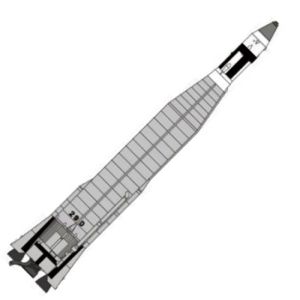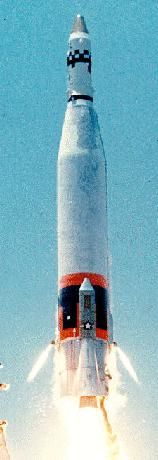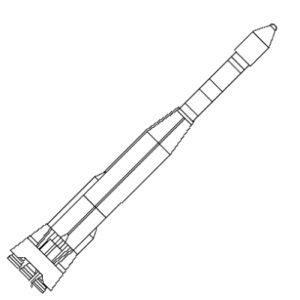
Home - Search - Browse - Alphabetic Index: 0- 1- 2- 3- 4- 5- 6- 7- 8- 9
A- B- C- D- E- F- G- H- I- J- K- L- M- N- O- P- Q- R- S- T- U- V- W- X- Y- Z
Atlas Agena A
 Atlas Agena A Atlas Agena A - Midas 2 - COSPAR 1960 Zeta |
AKA: Atlas-Hustler;LV-3A. Status: Retired 1961. First Launch: 1960-02-26. Last Launch: 1961-01-31. Number: 4 . Payload: 800 kg (1,760 lb). Thrust: 1,587.19 kN (356,815 lbf). Gross mass: 123,990 kg (273,350 lb). Height: 30.00 m (98.00 ft). Diameter: 3.05 m (10.00 ft). Apogee: 600 km (370 mi).
Payload: 800 kg (1,760 lb) to a GTO.
Stage Data - Atlas LV-3A / Agena A
- Stage 0. 1 x Atlas MA-2. Gross Mass: 3,050 kg (6,720 lb). Empty Mass: 3,050 kg (6,720 lb). Thrust (vac): 1,517.422 kN (341,130 lbf). Isp: 282 sec. Burn time: 135 sec. Isp(sl): 248 sec. Diameter: 4.90 m (16.00 ft). Span: 4.90 m (16.00 ft).Propellants: Lox/Kerosene. No Engines: 2. Engine: XLR-89-5. Status: Out of Production.
- Stage 1. 1 x Atlas Agena LV-3A. Gross Mass: 117,150 kg (258,270 lb). Empty Mass: 2,390 kg (5,260 lb). Thrust (vac): 363.218 kN (81,655 lbf). Isp: 309 sec. Burn time: 330 sec. Isp(sl): 215 sec. Diameter: 3.05 m (10.00 ft). Span: 4.90 m (16.00 ft). Length: 20.27 m (66.50 ft). Propellants: Lox/Kerosene. No Engines: 1. Engine: XLR-105-5. Status: Out of Production.
- Stage 2. 1 x Agena A. Gross Mass: 3,790 kg (8,350 lb). Empty Mass: 885 kg (1,951 lb). Thrust (vac): 68.950 kN (15,501 lbf). Isp: 276 sec. Burn time: 120 sec. Diameter: 1.52 m (4.98 ft). Span: 1.52 m (4.98 ft). Length: 4.73 m (15.51 ft). Propellants: Nitric acid/UDMH. No Engines: 1. Engine: Bell 8048. Other designations: RM-81. Status: Out of Production.
Historical Essay © Andreas Parsch
Lockheed RM-81 Agena
The Agena space vehicle was used in large numbers during the 1960s and 1970s as upper stage with SLV-2 Thor, SLV-3 Atlas and SLV-5 Titan boosters to launch a variety of military and civilian payloads into orbit. The Agena itself was actually the first general-purpose satellite, and formed the core for many operational satellites and experimental space vehicles. It is included in this missile directory, because the U.S. Air Force allocated the formal missile designator RM-81 to the Agena (see section on RM-81 Designation for details).
In 1955, the U.S. Air Force began its Weapons System 117L program, calling for the development of a strategic satellite system. The initial primary goal of WS-117L was the development an orbital photo-reconnaissance platform, and in October 1956, Lockheed became prime contractor for the system. The core element of WS-117L was a new multipurpose spacecraft with boost and manoeuvering engines, which would act as the second stage of the launch vehicle as well as the carrier vehicle for the reconnaissance system. Lockheed's Agena spacecraft was built around the Bell XLR81 liquid-propellant rocket engine, and was initially known informally as Hustler, because the XLR81 was originally developed for a (later cancelled) rocket-powered weapons pod for the B-58 Hustler bomber. The first launch of a Thor-Agena combination in January 1959 was a failure, but on 28 February that year, Agena scored its first success when a Thor-Agena launcher placed the Discoverer 1 satellite into polar orbit.
Agena A
The first few Agenas, including the vehicle used in the Discoverer 1 launch, used a Bell XLR81-BA-3 rocket engine, but most vehicles of the initial Agena A series used an XLR81-BA-5 (Bell Model 8048). The engine had gimballed nozzles for pitch and yaw control, and could deliver a thrust of 68.9 kN (15500 lb) for up to 120 s.
| Launch Vehicle Combination | Number of Launches | First/Last Launch |
| Thor (SLV-2) + Agena A | 16 | 21-Jan-1959 / 13-Sep-1960 |
| Atlas (LV-3A) + Agena A | 4 | 26-Feb-1960 / 31-Jan-1961 |
| Total for Agena A | 20 | 21-Jan-1959 / 31-Jan-1961 |
Launch summary for Agena A
The Thor-Agena A launched the initial reconnaissance satellites of the CORONA (publicly named Discoverer) series (KH-1 system), while the Atlas-Agena A was used for the first two launches of both the Midas (Missile Detection And Surveillance) early-warning system and Samos (Satellite and Missile Observation System) ELINT satellite series.
Agena B
The Agena B had an improved XLR81-BA-7 engine (Bell Model 8081), which could be restarted in space, and was stretched to carry much more propellant, doubling the total burn time to 240 s. Both features greatly increased the versatility of the Agena vehicle. When launched into low orbits, the Agena B had plenty of fuel left for extensive orbital manoeuvers, an important requirement for a reconnaissance platform. Later models of the Agena B used a further improved XLR81-BA-9 (Bell Model 8096) engine, which (among other changes) increased the thrust to 71.1 kN (16000 lb) by using a different type of fuel.
| Launch Vehicle Combination | Number of Launches | First/Last Launch |
| Thor (SLV-2) + Agena B | 44* | 26-Oct-1960 / 28-Aug-1964 |
| Thrust-Augmented Thor (SLV-2A/C) + Agena B | 3* | 29-Jun-1963 / 15-May-1966 |
| Atlas (LV-3A) + Agena B | 28 | 12-Jul-1961 / 21-Mar-1965 |
| Atlas (SLV-3) + Agena B | 1 | 9-Jun-1966 |
| Total for Agena B | 76 | 26-Oct-1960 / 9-Jun-1966 |
Launch summary for Agena B
* Thor variant counts slightly differ between sources, but Thor-Agena total is not in question
Most of the Thor-Agena B vehicles launched KH-series reconnaissance systems (all KH-2/3 CORONAs, and some satellites of the KH-4 CORONA and KH-5 ARGON series). The remainder included e.g. some ELINT systems of the Samos program. The Atlas-Agena B launched a variety of spacecraft, the major ones being Midas early-warning systems, Samos ELINT systems and Ranger space probes.
Agena C
The designation Agena C was reserved for a proposed enlarged variant, which was to have doubled the capability of the Agena B (most likely by doubling the fuel tank size). However, this version was not built.
Agena D
The majority of Agenas were of the final Agena D variant. This was essentially a "standardized" Agena B, which could accept a variety of payloads (in a conical payload section in the nose) and be fitted to Atlas, Thor or Titan launchers without changes to the basic Agena. The earlier Agena A/B vehicles were tailor-made for their respective payloads and launcher types. The Agena D launched a large number of military and scientific payloads, including e.g. the Gemini-Agena target vehicles used by NASA for space capsule docking experiments in 1966.
| Launch Vehicle Combination | Number of Launches | First/Last Launch |
| Thor (SLV-2) + Agena D | 22* | 28-Jun-1962 / 31-May-1967 |
| Thrust-Augmented Thor (SLV-2A/C) + Agena D | 60* | 28-Feb-1963 / 17-Jan-1968 |
| LTTAT** (SLV-2G/H) + Agena D | 22* | 9-Aug-1966 / 16-Jul-71 |
| Thorad (SLV-2G/H) + Agena D | 21* | 18-May-1968 / 25-May-72 |
| Atlas (LV-3A) + Agena D | 15 | 12-Jul-1963 / 20-Jul-1965 |
| Atlas (SLV-3) + Agena D | 48 | 14-Aug-1964 / 5-Nov-1967 |
| Atlas (SLV-3A) + Agena D | 12 | 4-Mar-1968 / 7-Apr-1978 |
| Atlas F + Agena D | 1 | 27-Jun-1978 |
| Titan 3B å (SLV-5B) | 29 | 29-Jul-1966 / 23-Oct-1970 |
| Titan 23B åå | 2 | 21-Jan-1971 / 22-Apr-1971 |
| Titan 33B åå | 3 | 21-Mar-1971 / 21-Aug-1973 |
| Titan 24B åå | 23 | 12-Aug-1971 / 21-Aug-1973 |
| Titan 34B åå | 11 | 10-Mar-1975 / 12-Feb-1987 |
| Total for Agena D | 269 | 28-Jun-1962 / 12-Feb-1987 |
Launch summary for Agena D
* Thor variant counts slightly differ between sources, but Thor-Agena total is not in question
** LTTAT = Long-Tank Thrust-Augmented Thor (quoted by some sources as identical to Thorad)
å Titan 3B was the designation for the Titan 3 + Agena D combination
åå These derivatives of the Titan 3B are sometimes called 3(23)B, 3(33B), 3(24)B and 3(34)B, respectively.
The majority of Agena D missions on Thor-type boosters launched KH-series reconnaissance systems, mostly CORONA (KH-4/4A/4B), but also ARGON (KH-5) and LANYARD (KH-6). Most of the initial Atlas-Agena D vehicles (LV-3A/SLV-3) launched GAMBIT satellites (KH-7 reconnaissance system) into orbit, but payloads also included the Mariner series of interplanetary probes and the GATV (Gemini-Agena Target Vehicle). The SLV-3A/Agena D was used to launch the CANYON and RHYOLITE/AQUACADE series of ELINT/SIGINT satellites into geostationary orbits.
The Titan 3B/23B/24B series launched GAMBIT (KH-8 reconnaissance system) satellites, while the payloads of the larger Titan 33B/34B boosters consisted of JUMPSEAT SIGINT and SDS communications satellites.
A total of 365 Agena vehicles of all types were launched into space by the U.S. Air Force and NASA between January 1959 and 12 February 1987, when the last Agena D was launched with a USAF payload (SDS communications satellite #7) as upper stage of a Titan 34B booster.
RM-81 DesignationIn 1958 (or early 1959), the U.S. Air Force allocated the formal "Research Missile" designation RM-81 to the Agena space vehicle. The reasons for this remain unclear, but the USAF possibly needed to assign a designator for formal purposes and there was no better alternative at that time. USAF serial number listings show a total order of 341 Agenas, designated as XRM-81, RM-81, SRM-81 and SRM-81A. Because I cannot connect these four designators in any way to the documented basic Agena variants (Agena A/B/D), I don't know what the significance of the different RM-81 designations is. The table below is a detailed listing of allocated Agena serial number blocks, sorted by type designation:
| Serial Range | Designation | Total Number Ordered |
| 59-2544/2557 60-606/615 60-5454/5463 60-6594/6630 60-6914/6922 62-12585 | XRM-81 | 81 |
| 60-3710/3719 | RM-81 | 10 |
| 63-7368/7406 63-12759/12764 65-10657/10685 66-4390/4432 66-9249/9262 67-14544/14579 | SRM-81 | 167 |
| 61-4530/4536 62-3876/3878 62-4614/4625 62-12202/12213 62-12289/12291 63-13040/13085 | SRM-81A | 83 |
Notes:
1. The Agena did not receive a new designation in June 1963, when the joint DOD missile designation system was introduced, because spacecraft were not originally part of the new system.
2. One would expect that SRM-81A designated a newer version than SRM-81 (before 1962, an "A" suffix designated the second version), but the latest blocks are all attributed to plain SRM-81. However, after June 1963 the Agena's designation was no longer covered by any official regulation, so it's possible that the general SRM-81 designator was not meant to designate any specific variant, but was only retained in the serial number list for informal purposes.
3. The 341 serials do not account for the full number of Agenas built (at least 365).
Note: Data given by several sources show slight variations. Figures given below may therefore be inaccurate! Because exact numbers for each Agena depend on payload configuration, the data are to be regarded as "typical" values.
Data for Agena A, Agena B, Agena D:
| Agena A | Agena B/D | |
| Length | 5.94 m (19.5 ft) | 7.56 m (24.8 ft) |
| Diameter | 1.52 m (5 ft) | |
| Weight | 3850 kg (8500 lb) Fuel: 2945 kg (6500 lb) | 7160 kg (15800 lb) Fuel: 6115 kg (13500 lb) |
| Propulsion | Bell XLR81-BA-5 liquid-fuel rocket; 68.9 kN (15500 lb) for 120 s | Bell XLR81-BA-9 liquid-fuel rocket; 71.1 kN (16000 lb) for 240 s |
[1] Jos Heyman: "World Spacecraft Digest 1957-2002", Tiros Space Information, 2003
[2] Jos Heyman: "Spacecraft Tables 1957-2002", Tiros Space Information, 2003
[3] RenÚ J. Francillon: "Lockheed Aircraft since 1913", Putnam, 1987
[4] Norman J. Bowman: "The Handbook of Rockets and Guided Missiles", Perastadion Press, 1963
[5] Mark Wade: Encyclopedia Astronautica
[6] Gunter Krebs: Gunter's Space Page
[7] USAF Aircraft Serial Number Records (data provided by Jos Heyman)
More at: Atlas Agena A.
Family: orbital launch vehicle. Country: USA. Engines: XLR105-5, XLR89-5, Bell 8048. Spacecraft: Aeronutronics Project 7969, Convair Project 7969, Lockheed Project 7969, Midas, Samos. Launch Sites: Cape Canaveral, Vandenberg, Cape Canaveral LC14, Vandenberg SLC3W. Stages: Agena A, Atlas MA-2, Atlas Agena LV-3A. Agency: Convair.
 | Atlas D Midas Credit: © Thomas Kladiva - Thomas Kladiva |
 | Atlas Agena A Credit: US Air Force |
 | Atlas Agena A Credit: © Mark Wade |
1958 March 5 - . LV Family: Thor, Atlas. Launch Vehicle: Thor Agena A, Atlas Agena A.
- USAF lead role in space reaffirmed. WS 117L to be prioritized. - .
Spacecraft: Man-In-Space-Soonest,
KH-1,
WS-117.
The Office of the Secretary of Defense, in the first significant forward step to accelerate development of a space capability, reiterated the space role of the Air Force. In addition to its missile programs the Air Force was responsible for the 117L system and "... has a recognized long term development responsibility for manned space flight capability with the primary objective of accomplishing satellite flight as soon as technology permits." Furthermore, the Air Force was told it was to carry forward and accelerate the Atlas 117L project "under the highest national priority in order to attain an initial operational capability in the earliest possible date," But the proposed interim system using a Thor booster combined with a second stage and recoverable capsule "should not be pursued. " The Department of Defense did agree that a Thor booster with a suitable second stage "may be the most promptly and readily available device for experimental flights with laboratory animals" and development of such hardware including a system for recovery of animals was authorized. (Msg 03-014, Cmdr ARDC, to Cmdr AFBMD, 5 Mar 58.)
1960 February 26 - . 17:25 GMT - . Launch Site: Cape Canaveral. Launch Complex: Cape Canaveral LC14. LV Family: Atlas. Launch Vehicle: Atlas Agena A. FAILURE: Second stage failed to separate.. Failed Stage: U.
- Midas 1 - .
Payload: Midas / Agena TV 1008. Mass: 2,025 kg (4,464 lb). Nation: USA.
Agency: USAF.
Class: Surveillance.
Type: Early warning satellite. Spacecraft Bus: WS-117.
Spacecraft: Midas.
Decay Date: 1960-02-26 .
The Air Force MIDAS I satellite was launched from Cape Canaveral in the first successful launch of the Atlas D/Agena A booster-upper stage combination. MIDAS I, however, failed to achieve orbit because an accident at the Atlas-Agena staging damaged the Agena. The entire vehicle reentered and burned up about 2,500 miles downrange. Missile Defense Alarm System.
1960 May 24 - . 17:36 GMT - . Launch Site: Cape Canaveral. Launch Complex: Cape Canaveral LC14. LV Family: Atlas. Launch Vehicle: Atlas Agena A.
- Midas 2 - .
Payload: Midas / Agena TV 1007. Mass: 2,300 kg (5,000 lb). Nation: USA.
Agency: USAF.
Class: Surveillance.
Type: Early warning satellite. Spacecraft Bus: WS-117.
Spacecraft: Midas.
Decay Date: 1974-02-07 . USAF Sat Cat: 43 . COSPAR: 1960-Zeta-1. Apogee: 494 km (306 mi). Perigee: 473 km (293 mi). Inclination: 33.00 deg. Period: 94.30 min.
Missile Defense Alarm System. Test launch with W-17 sensor. The last Atlas D/Agena A booster to be used by the Air Force placed into orbit the MIDAS II infrared scanning satellite designed to detect and give early warning of missile launchings. Although intended to function for 40 months, the satellite's telemetry system failed on 26 May. MIDAS II was the first early warning satellite system placed in orbit.
1960 October 11 - . 20:33 GMT - . Launch Site: Vandenberg. Launch Complex: Vandenberg SLC3W. LV Family: Atlas. Launch Vehicle: Atlas Agena A. FAILURE: Second stage failure.. Failed Stage: U.
- Samos 1 - . Payload: Samos E-1 no. 1. Mass: 1,845 kg (4,067 lb). Nation: USA. Agency: USAF. Class: Surveillance. Type: Military surveillance satellite. Spacecraft Bus: WS-117. Spacecraft: Samos. Decay Date: 1960-10-11 . First generation photo surveillance; radio relay of images; Satellite and Missile Observation Satellite..
1961 January 31 - . 20:21 GMT - . Launch Site: Vandenberg. Launch Complex: Vandenberg SLC3W. LV Family: Atlas. Launch Vehicle: Atlas Agena A.
- Samos 2 - .
Payload: Samos E-1 no. 2. Mass: 1,900 kg (4,100 lb). Nation: USA.
Agency: USAF.
Class: Surveillance.
Type: Military surveillance satellite. Spacecraft Bus: WS-117.
Spacecraft: Samos.
Decay Date: 1973-10-21 . USAF Sat Cat: 70 . COSPAR: 1961-Alpha-1. Apogee: 557 km (346 mi). Perigee: 474 km (294 mi). Inclination: 97.40 deg. Period: 95.00 min.
An Air Force Atlas D/Agena A was launched from Vandenberg and successfully placed the SAMOS II satellite into orbit. This was the last Air Force use of an Agena A upper stage vehicle. First generation photo surveillance; radio relay of images; micrometeoroid impact data. Poor results.
Back to top of page
Home - Search - Browse - Alphabetic Index: 0- 1- 2- 3- 4- 5- 6- 7- 8- 9
A- B- C- D- E- F- G- H- I- J- K- L- M- N- O- P- Q- R- S- T- U- V- W- X- Y- Z
© 1997-2019 Mark Wade - Contact
© / Conditions for Use